Abstract
1. Systemic and regional haemodynamic responses, including superior mesenteric artery blood flow, were measured during stimuli which increase sympatho-neural activity in age-matched normal subjects (controls) and in two groups of patients with sympathetic failure (pure autonomic failure and multiple system atrophy). The stimuli included the pressor tests (mental arithmetic, cutaneous cold and isometric exercise) and head-up tilt. 2. In the controls, the blood pressure did not rise in some during mental arithmetic, but rose in all subjects during cutaneous cold and isometric exercise and was maintained during head-up tilt. In sympathetic failure patients, blood pressure was unchanged during each pressor test and fell during head-up tilt. 3. In the controls, superior mesenteric artery blood flow did not fall significantly during mental arithmetic but fell (with a corresponding rise in calculated superior mesenteric artery vascular resistance), during cutaneous cold, isometric exercise and head-up tilt. In sympathetic failure patients, there were no changes in superior mesenteric artery blood flow and vascular resistance during the pressor tests and head-up tilt. 4. There were no changes in cardiac index or forearm blood flow during each pressor test in both controls and patients. Cardiac index fell and forearm vascular resistance rose during head-up tilt in the controls only. 5. In conclusion, active constriction of the superior mesenteric artery occurs in normal subjects during sympatho-neural activation induced by stimuli such as cutaneous cold, isometric exercise and head-up tilt. This does not occur in patients with sympathetic failure and probably contributes to postural hypotension, emphasizing the role of the splanchnic vascular bed in overall blood pressure control. This study confirms the necessity of integrity of sympathetic pathways in the neural control of the splanchnic vascular bed.
Full text
PDF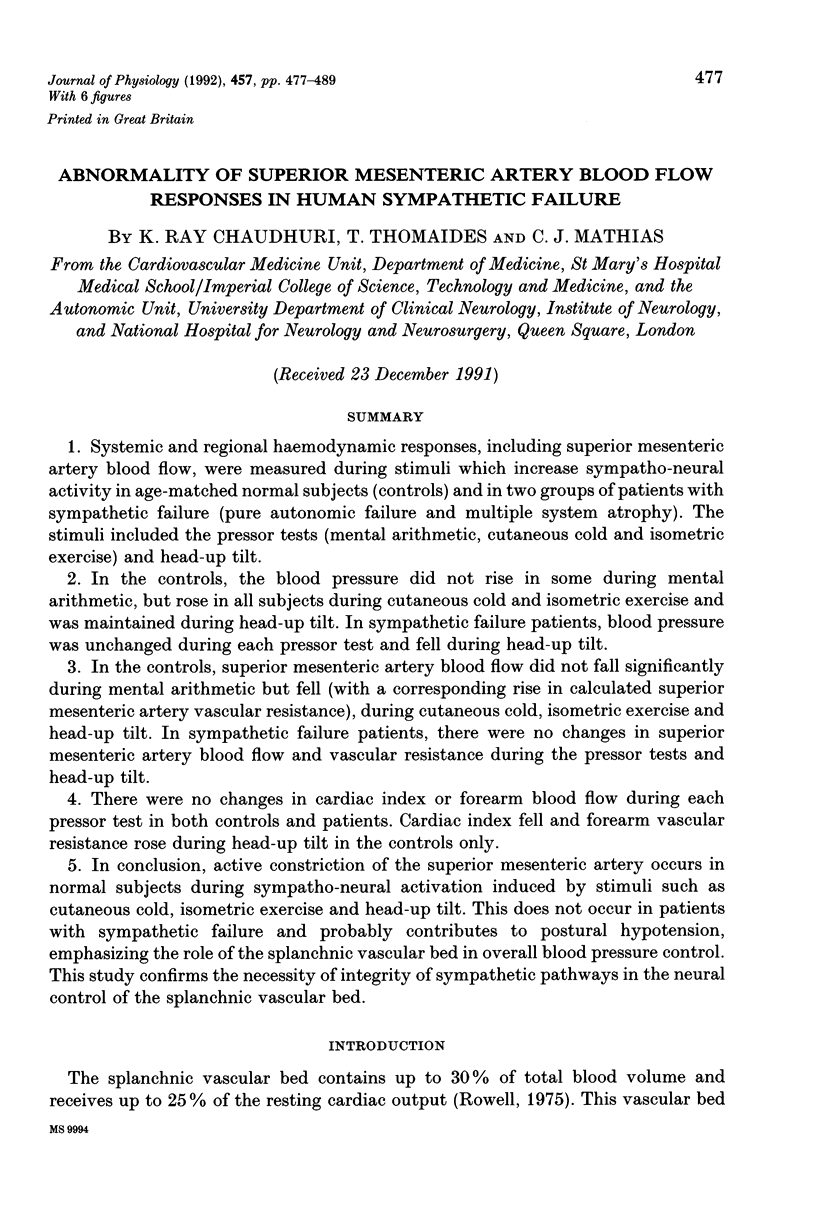
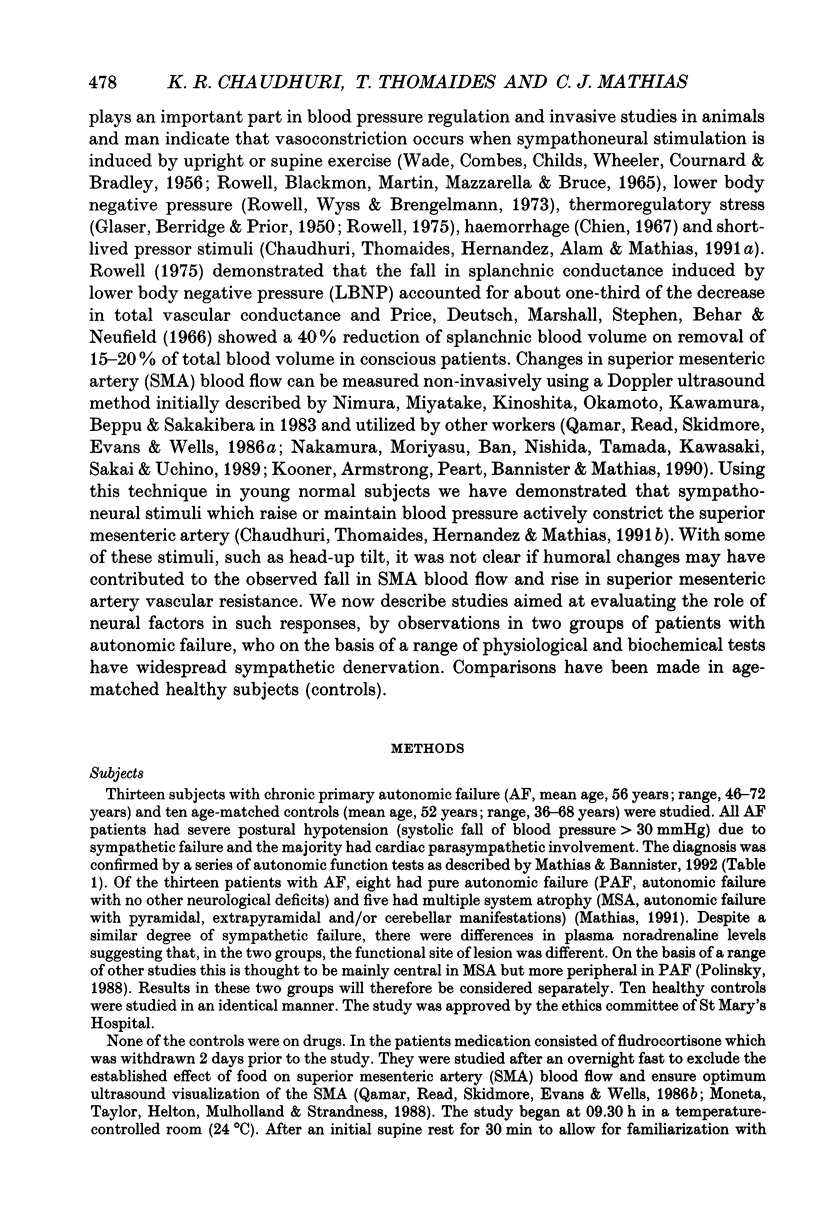
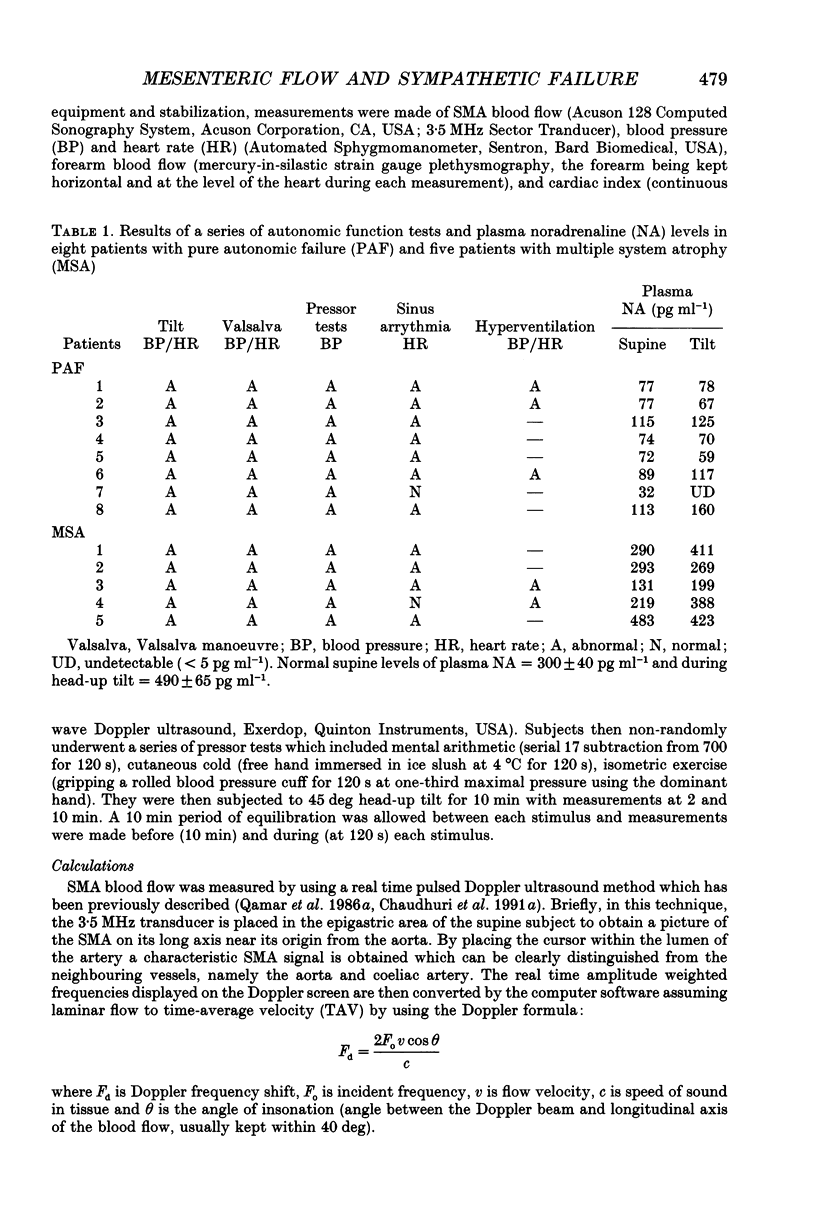
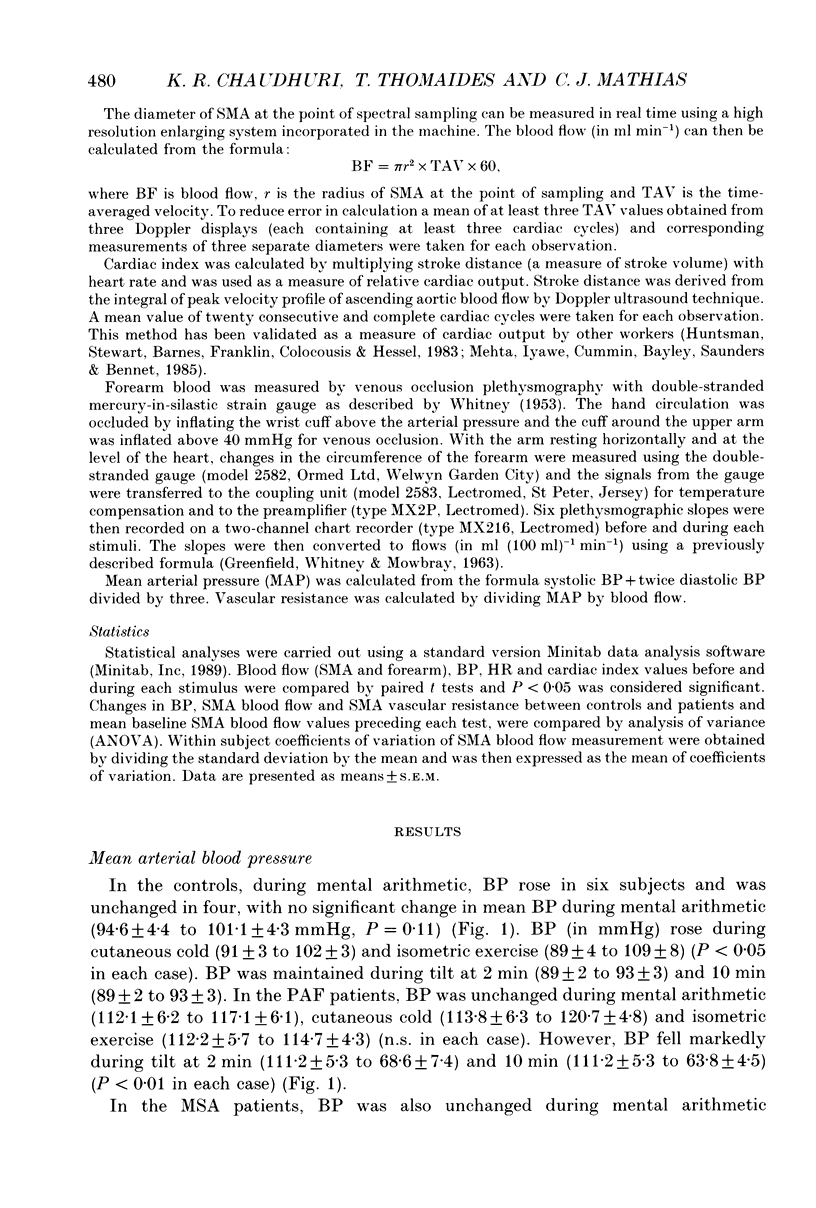

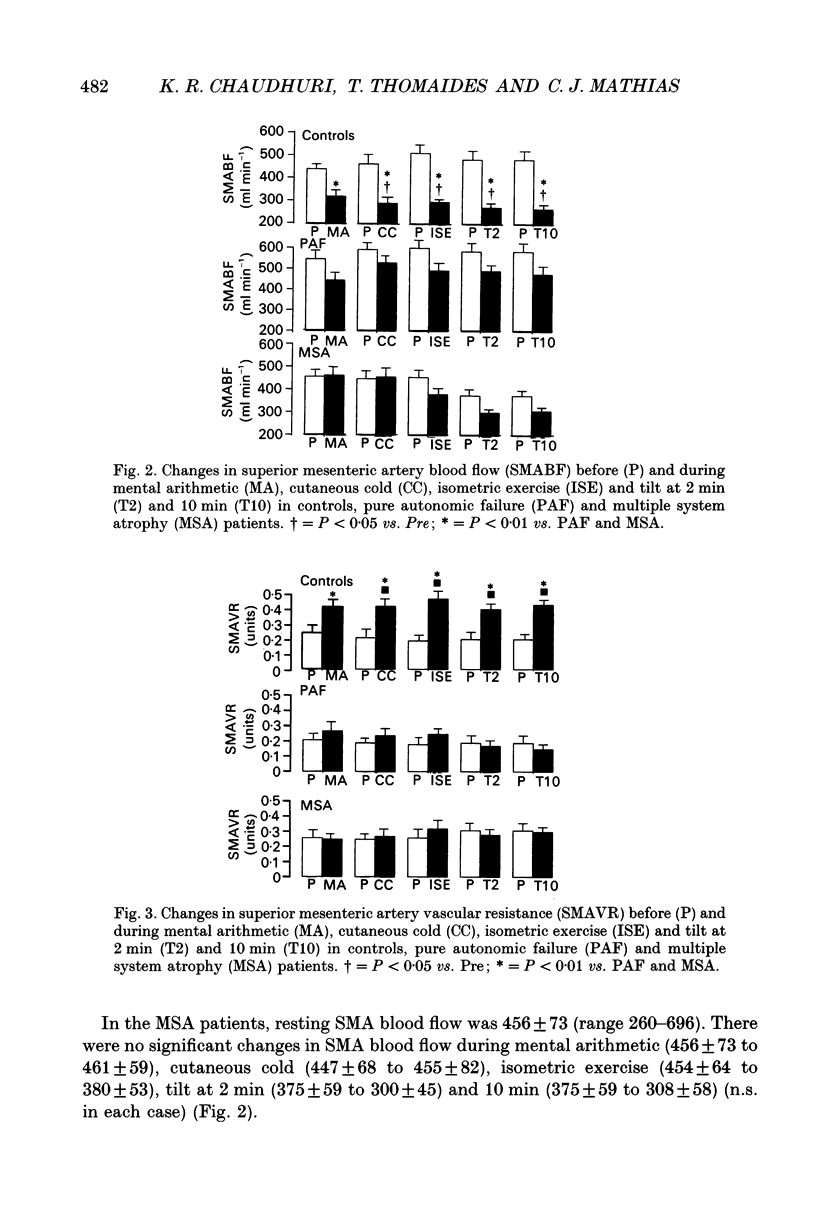
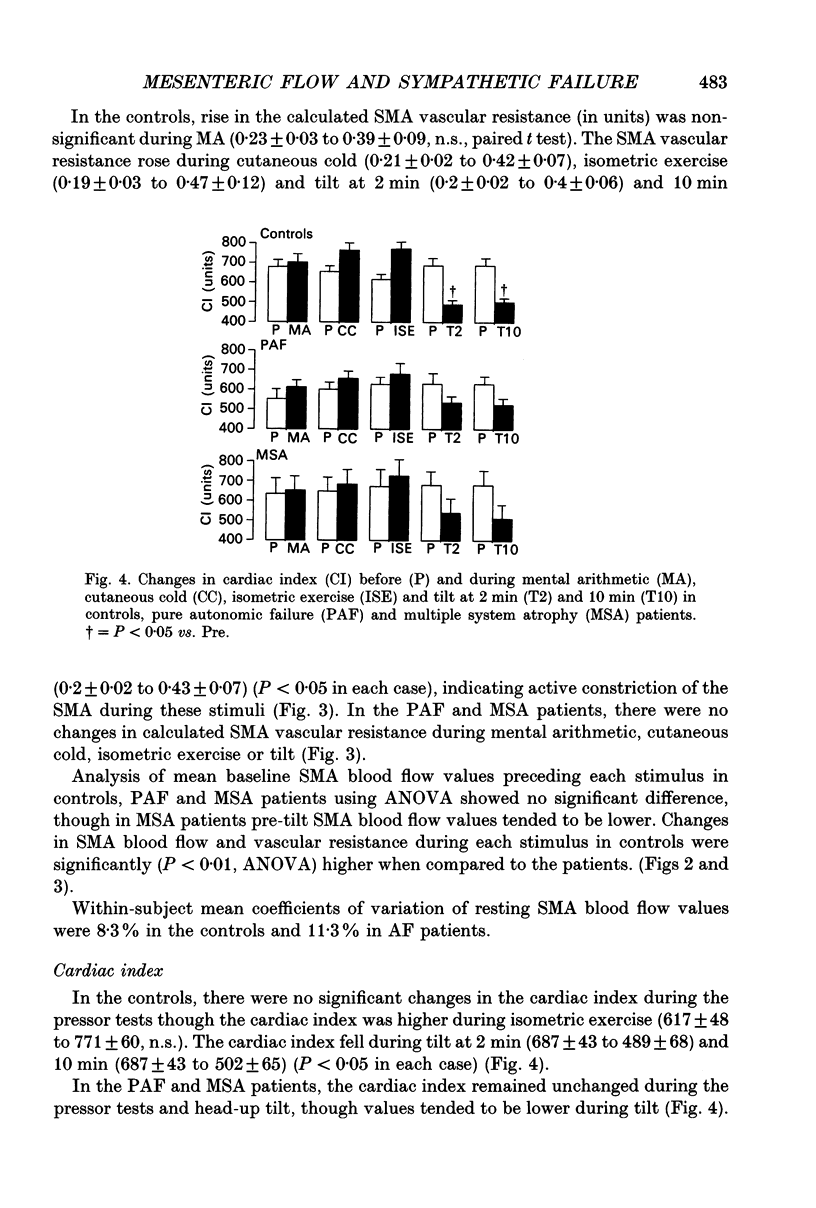
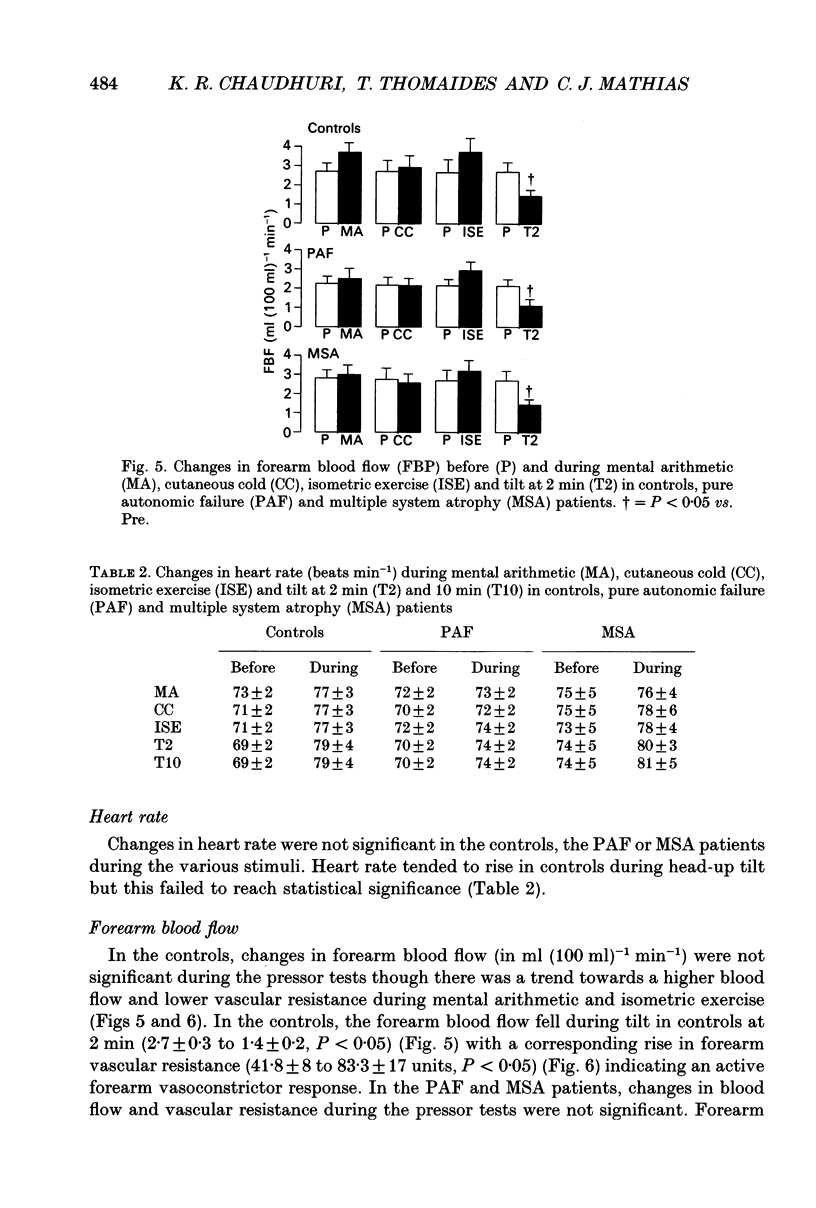
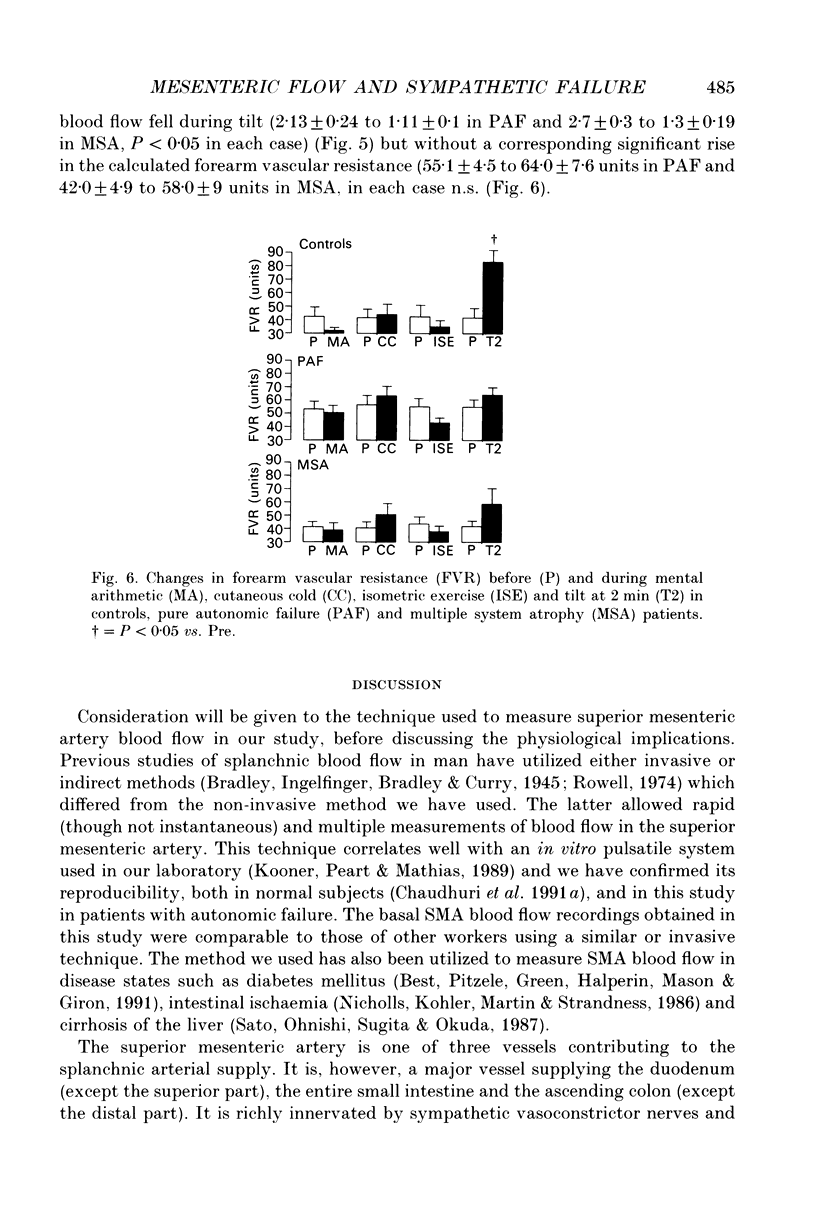
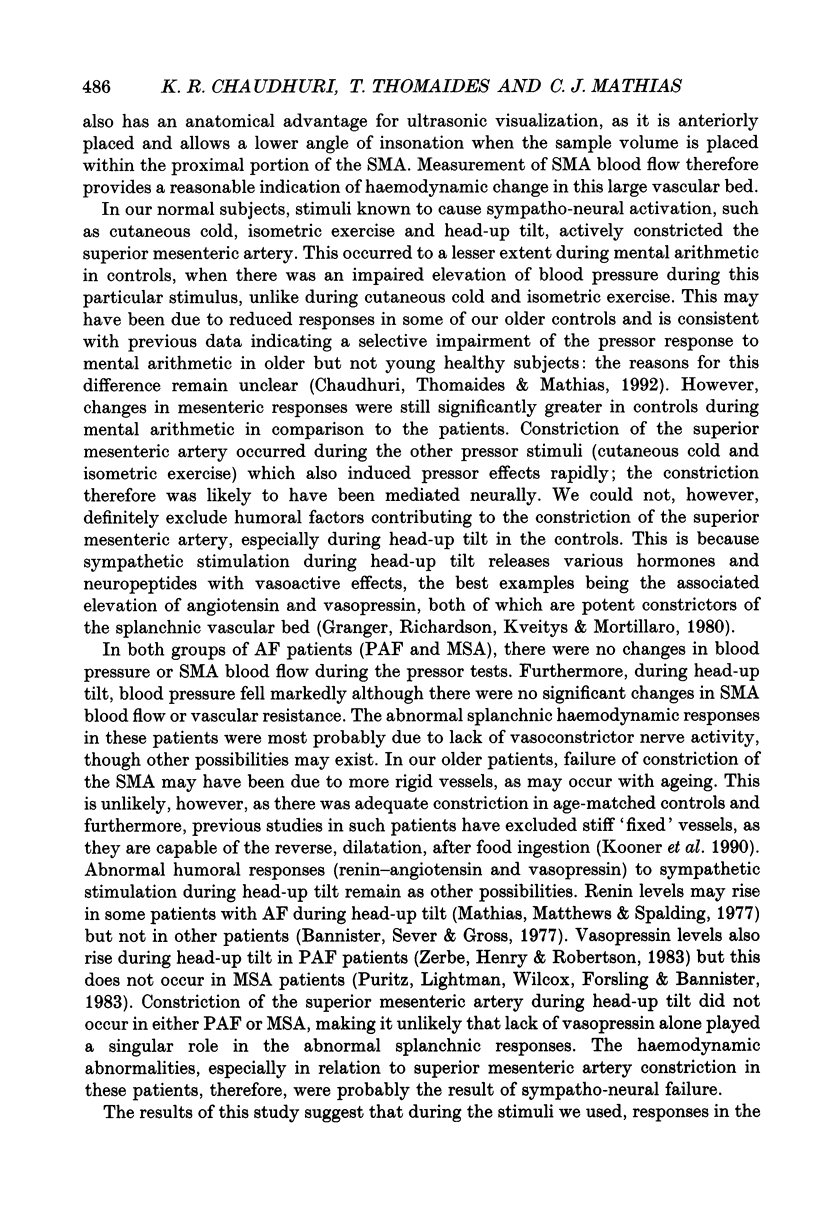
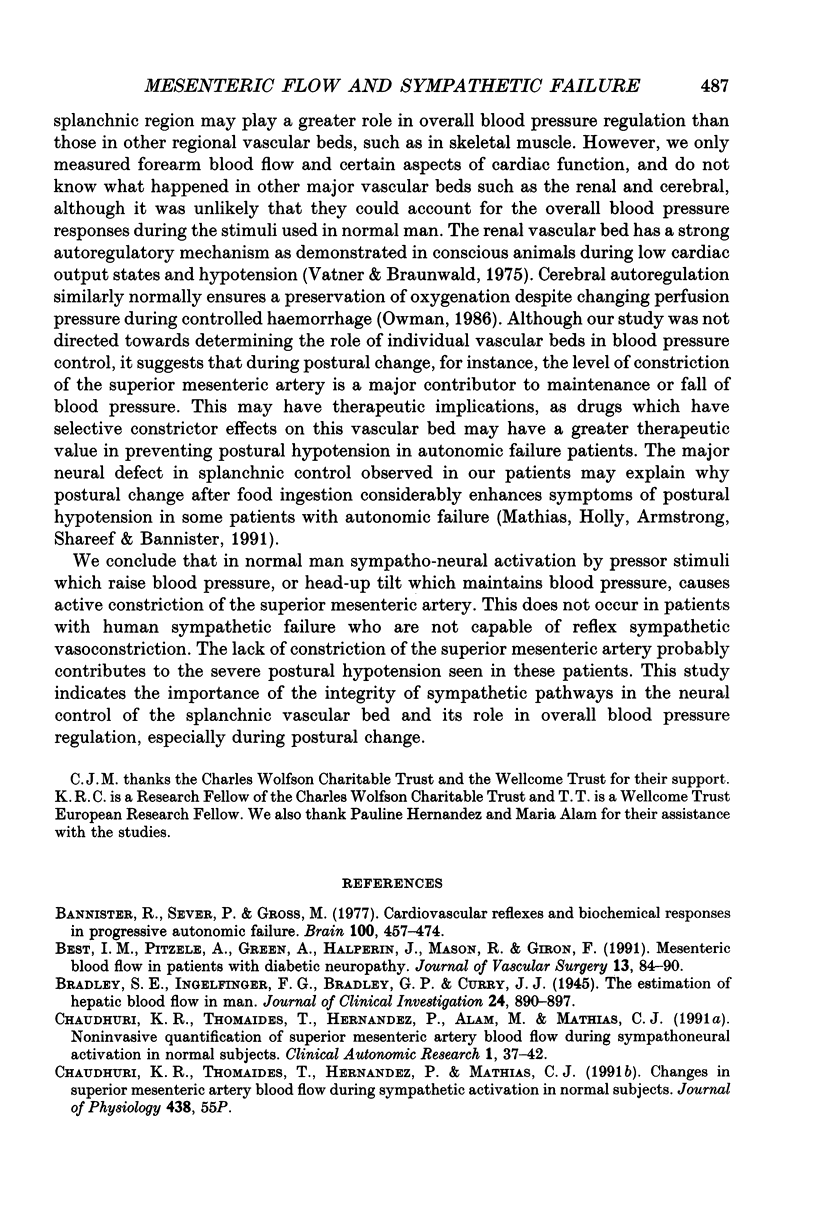

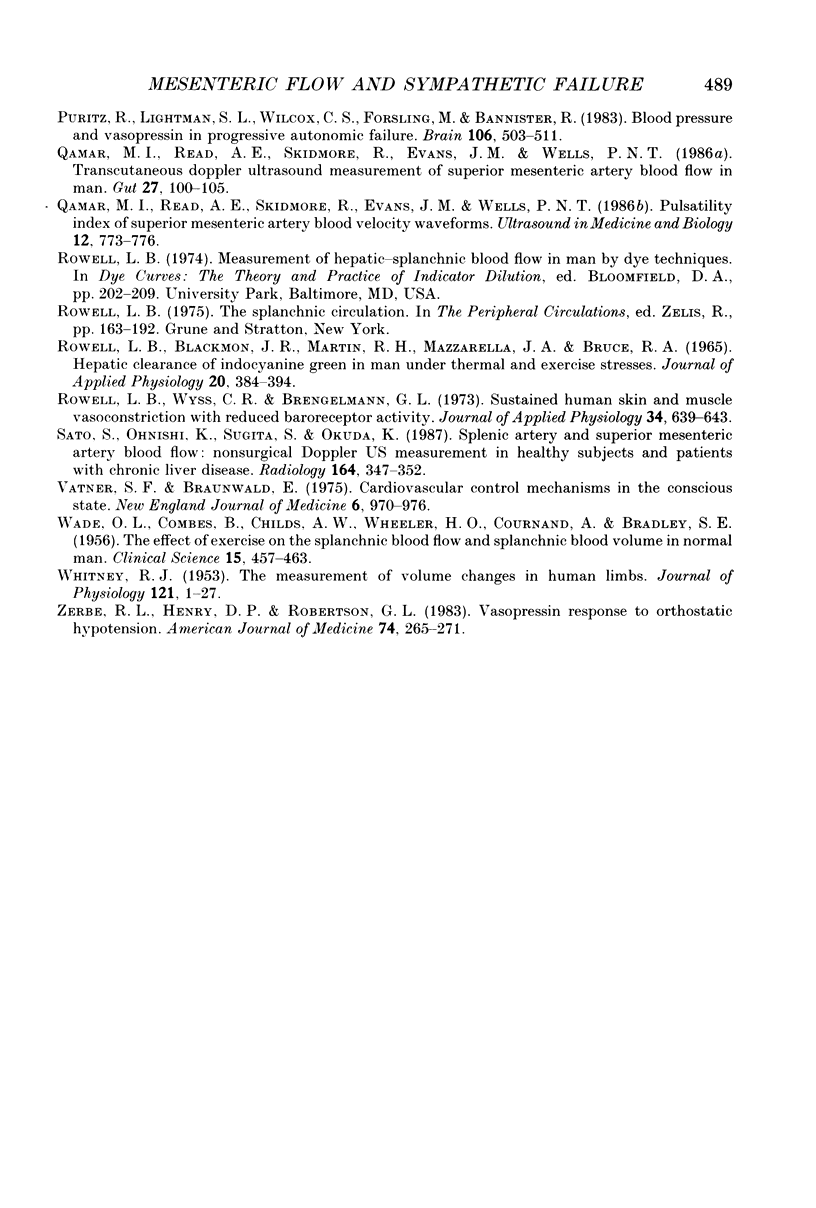
Selected References
These references are in PubMed. This may not be the complete list of references from this article.
- BRADLEY S. E., CHILDS A. W., COMBES B., COURNAND A., WADE O. L., WHEELER H. O. The effect of exercise on the splanchnic blood flow and splanchnic blood volume in normal man. Clin Sci. 1956 Aug;15(3):457–463. [PubMed] [Google Scholar]
- Best I. M., Pitzele A., Green A., Halperin J., Mason R., Giron F. Mesenteric blood flow in patients with diabetic neuropathy. J Vasc Surg. 1991 Jan;13(1):84–90. [PubMed] [Google Scholar]
- Bradley S. E., Ingelfinger F. J., Bradley G. P., Curry J. J. THE ESTIMATION OF HEPATIC BLOOD FLOW IN MAN. J Clin Invest. 1945 Nov;24(6):890–897. doi: 10.1172/JCI101676. [DOI] [PMC free article] [PubMed] [Google Scholar]
- Chaudhuri K. R., Thomaides T., Hernandez P., Alam M., Mathias C. J. Noninvasive quantification of superior mesenteric artery blood flow during sympathoneural activation in normal subjects. Clin Auton Res. 1991 Mar;1(1):37–42. doi: 10.1007/BF01826056. [DOI] [PubMed] [Google Scholar]
- Chien S. Role of the sympathetic nervous system in hemorrhage. Physiol Rev. 1967 Apr;47(2):214–288. doi: 10.1152/physrev.1967.47.2.214. [DOI] [PubMed] [Google Scholar]
- Clinical Autonomic Research Society Proceedings. Abstracts. Clin Auton Res. 1992 Feb;2(1):57–74. [PubMed] [Google Scholar]
- GREENFIELD A. D., WHITNEY R. J., MOWBRAY J. F. Methods for the investigation of peripheral blood flow. Br Med Bull. 1963 May;19:101–109. doi: 10.1093/oxfordjournals.bmb.a070026. [DOI] [PubMed] [Google Scholar]
- Granger D. N., Richardson P. D., Kvietys P. R., Mortillaro N. A. Intestinal blood flow. Gastroenterology. 1980 Apr;78(4):837–863. [PubMed] [Google Scholar]
- Huntsman L. L., Stewart D. K., Barnes S. R., Franklin S. B., Colocousis J. S., Hessel E. A. Noninvasive Doppler determination of cardiac output in man. Clinical validation. Circulation. 1983 Mar;67(3):593–602. doi: 10.1161/01.cir.67.3.593. [DOI] [PubMed] [Google Scholar]
- Kooner J. S., Peart W. S., Mathias C. J. The peptide release inhibitor, Octreotide (SMS 201-995), prevents the haemodynamic changes following food ingestion in normal human subjects. Q J Exp Physiol. 1989 Jul;74(4):569–572. doi: 10.1113/expphysiol.1989.sp003308. [DOI] [PubMed] [Google Scholar]
- Mathias C. J., Holly E., Armstrong E., Shareef M., Bannister R. The influence of food on postural hypotension in three groups with chronic autonomic failure--clinical and therapeutic implications. J Neurol Neurosurg Psychiatry. 1991 Aug;54(8):726–730. doi: 10.1136/jnnp.54.8.726. [DOI] [PMC free article] [PubMed] [Google Scholar]
- Mathias C. J., Matthews W. B., Spalding J. M. Postural changes in plasma renin activity and responses to vasoactive drugs in a case of Shy-Drager syndrome. J Neurol Neurosurg Psychiatry. 1977 Feb;40(2):138–143. doi: 10.1136/jnnp.40.2.138. [DOI] [PMC free article] [PubMed] [Google Scholar]
- Mehta N., Iyawe V. I., Cummin A. R., Bayley S., Saunders K. B., Bennett E. D. Validation of a Doppler technique for beat-to-beat measurement of cardiac output. Clin Sci (Lond) 1985 Oct;69(4):377–382. doi: 10.1042/cs0690377. [DOI] [PubMed] [Google Scholar]
- Moneta G. L., Taylor D. C., Helton W. S., Mulholland M. W., Strandness D. E., Jr Duplex ultrasound measurement of postprandial intestinal blood flow: effect of meal composition. Gastroenterology. 1988 Nov;95(5):1294–1301. doi: 10.1016/0016-5085(88)90364-2. [DOI] [PubMed] [Google Scholar]
- Nakamura T., Moriyasu F., Ban N., Nishida O., Tamada T., Kawasaki T., Sakai M., Uchino H. Quantitative measurement of abdominal arterial blood flow using image-directed Doppler ultrasonography: superior mesenteric, splenic, and common hepatic arterial blood flow in normal adults. J Clin Ultrasound. 1989 May;17(4):261–268. doi: 10.1002/jcu.1870170406. [DOI] [PubMed] [Google Scholar]
- Nicholls S. C., Kohler T. R., Martin R. L., Strandness D. E., Jr Use of hemodynamic parameters in the diagnosis of mesenteric insufficiency. J Vasc Surg. 1986 Mar;3(3):507–510. doi: 10.1067/mva.1986.avs0030507. [DOI] [PubMed] [Google Scholar]
- Nimura Y., Miyatake K., Kinoshita N., Okamoto M., Kawamura S., Beppu S., Sakakibara H. New approach to noninvasive assessment of blood flow in the major arteries in the abdomen by two-dimensional Doppler echography. Ultrasound Med Biol. 1983;Suppl 2:447–451. [PubMed] [Google Scholar]
- Price H. L., Deutsch S., Marshall B. E., Stephen G. W., Behar M. G., Neufeld G. R. Hemodynamic and metabolic effects of hemorrhage in man, with particular reference to the splanchnic circulation. Circ Res. 1966 May;18(5):469–474. doi: 10.1161/01.res.18.5.469. [DOI] [PubMed] [Google Scholar]
- Puritz R., Lightman S. L., Wilcox C. S., Forsling M., Bannister R. Blood pressure and vasopressin in progressive autonomic failure. Response to postural stimulation, L-dopa and naloxone. Brain. 1983 Jun;106(Pt 2):503–511. doi: 10.1093/brain/106.2.503. [DOI] [PubMed] [Google Scholar]
- Qamar M. I., Read A. E., Skidmore R., Evans J. M., Wells P. N. Pulsatility index of superior mesenteric artery blood velocity waveforms. Ultrasound Med Biol. 1986 Oct;12(10):773–776. doi: 10.1016/0301-5629(86)90074-8. [DOI] [PubMed] [Google Scholar]
- Qamar M. I., Read A. E., Skidmore R., Evans J. M., Wells P. N. Transcutaneous Doppler ultrasound measurement of superior mesenteric artery blood flow in man. Gut. 1986 Jan;27(1):100–105. doi: 10.1136/gut.27.1.100. [DOI] [PMC free article] [PubMed] [Google Scholar]
- Rowell L. B., Blackmon J. R., Martin R. H., Mazzarella J. A., Bruce R. A. Hepatic clearance of indocyanine green in man under thermal and exercise stresses. J Appl Physiol. 1965 May;20(3):384–394. doi: 10.1152/jappl.1965.20.3.384. [DOI] [PubMed] [Google Scholar]
- Rowell L. B., Wyss C. R., Brengelmann G. L. Sustained human skin and muscle vasoconstriction with reduced baroreceptor activity. J Appl Physiol. 1973 May;34(5):639–643. doi: 10.1152/jappl.1973.34.5.639. [DOI] [PubMed] [Google Scholar]
- Sato S., Ohnishi K., Sugita S., Okuda K. Splenic artery and superior mesenteric artery blood flow: nonsurgical Doppler US measurement in healthy subjects and patients with chronic liver disease. Radiology. 1987 Aug;164(2):347–352. doi: 10.1148/radiology.164.2.2955448. [DOI] [PubMed] [Google Scholar]
- Vatner S. F., Braunwald E. Cardiovascular control mechanisms in the conscious state. N Engl J Med. 1975 Nov 6;293(19):970–976. doi: 10.1056/NEJM197511062931906. [DOI] [PubMed] [Google Scholar]
- WHITNEY R. J. The measurement of volume changes in human limbs. J Physiol. 1953 Jul;121(1):1–27. doi: 10.1113/jphysiol.1953.sp004926. [DOI] [PMC free article] [PubMed] [Google Scholar]
- Zerbe R. L., Henry D. P., Robertson G. L. Vasopressin response to orthostatic hypotension. Etiologic and clinical implications. Am J Med. 1983 Feb;74(2):265–271. doi: 10.1016/0002-9343(83)90625-3. [DOI] [PubMed] [Google Scholar]


